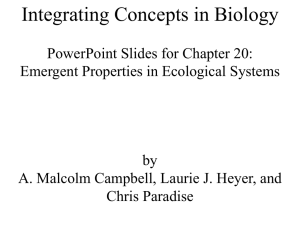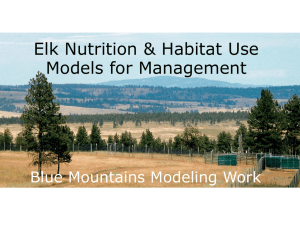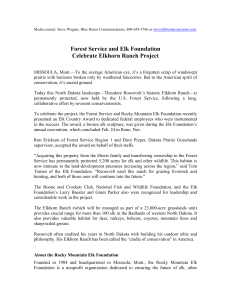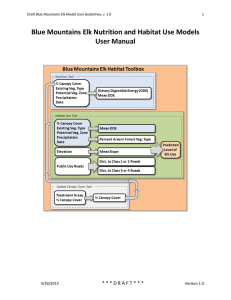Example Application of the Late Summer Elk Nutrition and Habitat Models Mount Emily
advertisement
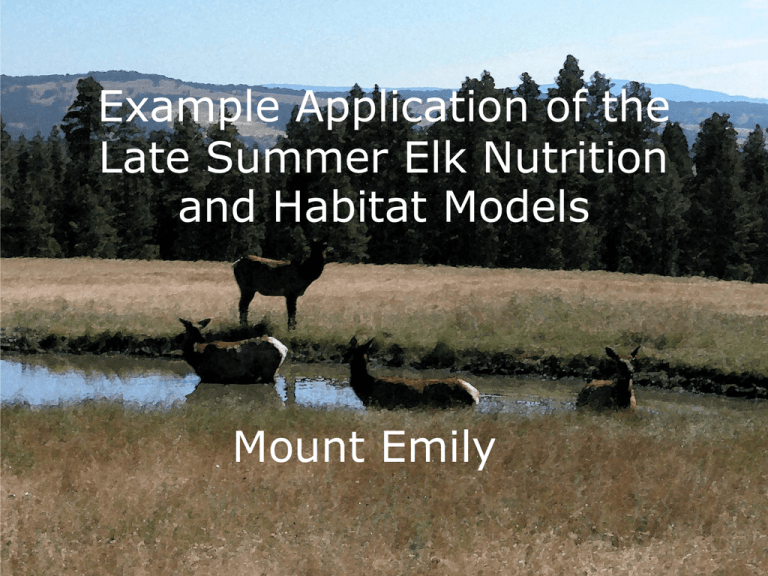
Example Application of the Late Summer Elk Nutrition and Habitat Models Mount Emily Topics to Discuss Describe the elk management situation in the Mt. Emily area. Present results of a hypothetical management option to illustrate how the models operate to evaluate changes to elk habitat. Summarize some observed strengths and weaknesses of the models in relation to results for this case example. Mt. Emily Area 128,863 acres Management Situation The Mt. Emily area straddles a zone where the moisture gradient shifts from wetter to the north and drier to the south. This moisture gradient is reflected in patterns of increasingly wet forests to the north and east, and increasingly dry forests to the south and west. This spatial variation in precipitation drives the potential for elk habitat enhancement across the area. Management Situation Mt. Emily Management Objective for elk – 5,700 Current population estimate – 3,400 The Mt. Emily WMU is managed for mature bulls Distribution of elk is not a major issue in the Mt. Emily area, but localized issues exist (E.g. Hunter Road) Predation Management Situation Most of the area is composed of National Forest System lands, that function primarily as summer range for elk. The area is administered by two National Forests, with strikingly different approaches to motorized access management. Small amounts of winter range exist on the southern and eastern portions of the area on a mix of National Forest, state, and private lands. Management Questions What potential exists for enhancing elk habitat use during late summer (pre-hunt period) in the area? How do road closures change the probability of elk use at the regional scale, and at local scales? How does forage enhancement effect probability of elk use? How do road closures and forage enhancements combined change elk use? Management Options Option 1: Identify road and motorized trail closures across the Mt. Emily area to improve summer range conditions for elk. Option 2 (not fully developed): Nutrition enhancement through reducing canopy closure in wet forests (just in Green/Huckle local area). Scales of Analysis Mt. Emily (regional landscape) Green/Huckleberry (local landscape) Walker/Pelican (local landscape) Nutrition Model Results Predicts dietary digestible energy (DDE) for elk during late summer (August) across entire landscape of interest (regional landscape) and for any smaller areas (local landscape) within the larger area. Model developed from tame elk grazing trials conducted in Blue Mountains, as described earlier. Estimates of DDE vary strongly with the potential vegetation types occuring in a given area and associated precipitation. Percent Area in DDE Class Habitat Model Results Predicts the relative probability of elk use across a landscape of interest (regional landscape) and for any smaller areas (local landscape) within the larger area. Model based on 5 covariates (predictor variables). Can be used to evaluate habitat conditions and how management actions can influence elk use on regional or local landscapes. Habitat Model (5 covariates) 1. Dietary Digestible Energy of Forage. 2. Distance to Class 1 or 2 Open Roads. 3. Distance to Class 3 or 4 Open Roads. 4. Slope. 5. Percent Area in Forest Vegetation Types. Percent Increase in Elk Use from Existing Condition for Option 1 60.0 53.0 % Change 50.0 40.0 30.0 20.0 10.0 11.0 1.5 0.0 Regional Landscape Local 1 (WalkerPelican) Local 2 (GreenHuckle) Relative probability of elk use increased by 11% for the regional landscape under option 1, and most of this increase occurred in the Green/Huckle local area (53%). General Observations of Model Results The nutrition and habitat model evaluations of late summer conditions appear to be realistic for the Mt. Emily Area. Nutrition and predicted habitat use are substantially higher in the north and east, which reflects local knowledge about habitat conditions. Late summer nutrition is more limited in the south, which also reflects local knowledge. General Observations of Model Results The potential for enhancing habitat use is greater in areas with more wet forests, owing to the higher background nutritional conditions in these areas. Road closures focused in areas of higher nutrition will increase elk use substantially more than road closures in areas of lower nutrition. Areas with more wet forests provide an opportunity for enhancing nutrition in combination with road closures to further enhance elk use. Model Strengths Many possible types of summaries in space and time, particularly public vs. private lands questions regarding predicted elk habitat use. Ability to summarize at regional and local scales Calculating the change in relative probability of use over time Model Strengths Calculating percentage of the landscape by condition classes (nutrition or relative use) Summing the relative probabilities of elk use for any specified area—the entire regional landscape or any areas within it (local landscapes) Model Weakness Limited season of application. Spring and hunting season models would address other critical time periods for elk. Management Questions What potential exists for enhancing elk habitat use during late summer (pre-hunt period) in the area? How do road closures change the probability of elk use at the regional scale, and at local scales? How does forage enhancement effect probability of elk use? How do road closures and forage enhancements combined change elk use? Questions?





